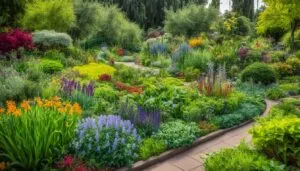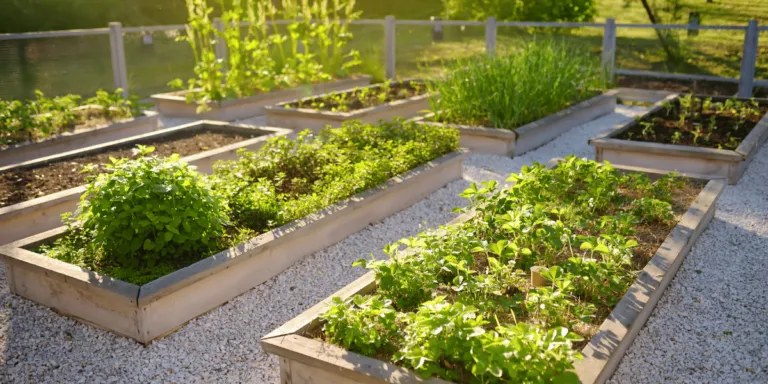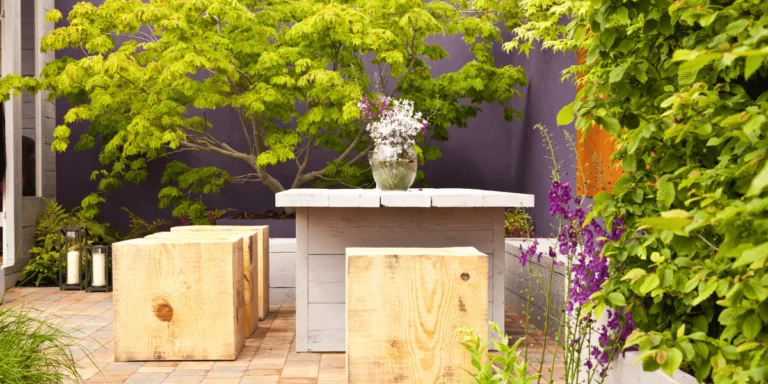Around 87% of households in the UK have a garden, but an increasing amount of garden space is being lost to hard surfacing. This loss of gardens is detrimental to wildlife. However, even small changes can make a difference and help create a haven for wildlife in urban spaces. This section will explore seven easy ways to make your garden wildlife-friendly.
Key Takeaways:
- Creating wildlife-friendly gardens is essential for sustaining urban biodiversity.
- Sustainable urban gardening practices promote eco-friendly landscape design.
- Innovative water conservation techniques can be employed to support wildlife habitats.
- Planting butterfly-friendly species attracts pollinators and enhances biodiversity.
- Bird feeders and appropriate bird food choices help support avian populations.
Grow butterfly-friendly plants
Attracting butterflies to your garden can be a delightful way to enhance the beauty and biodiversity of your outdoor space. By growing a variety of butterfly-friendly plants, you can create a welcoming habitat for these enchanting pollinators.
Butterflies and moths rely on nectar from various flower species as a source of food. However, their caterpillars have specific plant species they depend on for survival. By including a range of plants that flower at different stages, you can support both adult butterflies and their caterpillars.
One example of a butterfly species with specific plant preferences is the brimstone butterfly. Brimstone butterflies specifically feed on buckthorn bushes (Rhamnus species). By planting buckthorn bushes in your garden, you can attract these stunning creatures and provide them with a vital food source.
When selecting butterfly-friendly plants, it’s important to consider the shape of the flowers, as different insects are attracted to different shapes. Some butterflies, for example, are drawn to flowers with flat landing platforms, while others are more attracted to flowers with tubular shapes.
Tips for creating a butterfly-friendly garden:
- Choose a variety of plant species that bloom at different times to provide a continuous nectar source.
- Include plants that caterpillars rely on for their growth and development.
- Consider the shape of the flowers to attract a diverse range of butterfly species.
- Avoid the use of pesticides, as they can be harmful to butterflies and other beneficial insects.
- Provide areas of shade and shelter for butterflies to rest and seek protection.
To further encourage butterflies to visit your garden, you can incorporate a butterfly feeding station. These stations typically consist of a shallow dish filled with a solution of ripe fruit, water, and sugar. This mixture provides an additional source of nourishment for butterflies.
By creating a garden that caters to the needs of butterflies and their caterpillars, you can play a vital role in supporting and conserving these beautiful creatures. Not only will your garden become a haven for butterflies, but it will also contribute to the overall health and diversity of pollinators in your area.
Butterfly-friendly plants
| Plant Species | Flower Color | Attracts |
|---|---|---|
| Lavender | Purple | Brimstone butterflies, Small tortoiseshell butterflies |
| Buddleia | Purple, Pink, White | Painted lady butterflies, Peacock butterflies |
| Marigold | Orange, Yellow | Small copper butterflies, Common blue butterflies |
| Verbena | Purple, Pink, Red, White | Red admiral butterflies, Large white butterflies |
| Borage | Blue | Comma butterflies, Holly blue butterflies |
Feed the Birds
Installing bird feeders in your garden is a great way to attract a variety of bird species. Not only does it provide them with a reliable source of food, but it also allows you to observe these beautiful creatures up close. Bird feeders come in various types, such as seed feeders, suet feeders, and peanut feeders. You can even make your own bird feeder using a recycled plastic bottle.
When choosing bird food for your feeder, it’s important to consider the preferences of different bird species. Here are some common bird foods:
- Mealworms: Mealworms are a favorite among insect-eating birds like sparrows, robins, and bluebirds. They are rich in protein and provide essential nutrients.
- Niger Seeds: Niger seeds, also known as thistle seeds, are loved by finches, especially goldfinches. These small seeds are packed with oils and provide a high-energy food source.
- Fat Balls: Fat balls are a combination of suet, seeds, and grains. They are a favorite among a wide range of bird species and provide a high-calorie meal.
To ensure that your bird feeders are squirrel-proof, consider using feeders with mechanisms that prevent squirrels from raiding the food. This will help ensure that the birds get their fair share of the feast.
Remember to clean your bird feeder regularly to prevent the spread of diseases. Wash all parts of the feeder with hot, soapy water and rinse thoroughly before refilling it with fresh bird food. This practice will help keep the birds healthy and happy.
Get the Most from Compost
Composting is not only an eco-friendly way to reduce landfill waste but also a valuable method to enhance the health and fertility of your garden soil. By creating a compost heap using kitchen waste, you can harness the power of nature to provide essential nutrients for your plants while creating a thriving habitat for minibeasts and other wildlife.
Minibeasts, such as millipedes, woodlice, and spiders, are attracted to the moist and nutrient-rich environment of the compost heap. These creatures play a vital role in breaking down organic material and improving soil drainage. They contribute to the decomposition process by feeding on decaying matter and aerating the compost, allowing beneficial bacteria to thrive and accelerate the breakdown of organic waste.
Pro tip: Adding worms to your compost heap can further enhance its efficiency. Worms are excellent decomposers and help to break down organic matter more quickly. They also improve soil structure, promoting better root growth and enhancing soil fertility.
Furthermore, slugs and snails can be added to the compost heap as an important source of food for other wildlife. These creatures are natural scavengers and contribute to the ecological balance of the compost ecosystem.
To ensure the health of the minibeasts and microorganisms in your compost, it’s crucial to avoid using pesticides that can harm these beneficial creatures. Embrace organic gardening practices and rely on natural methods to control pests in your garden.
Not only does composting benefit wildlife, but it also provides essential nutrients for your garden. The decomposed organic material, also known as humus, enriches the soil by releasing nutrients slowly over time. This nutrient-rich soil amendment promotes healthy plant growth, improves soil structure, and enhances water retention capacity.
Embrace the power of composting to nourish your garden, support local wildlife, and cultivate a sustainable and vibrant ecosystem in your urban space.
| Benefits of Composting: | How it Benefits Wildlife: |
|---|---|
| 1. Reduces landfill waste | 1. Provides a habitat for minibeasts like millipedes, woodlice, and spiders |
| 2. Enriches soil with essential nutrients | 2. Attracts slugs and snails as a food source for other wildlife |
| 3. Improves soil structure and drainage | 3. Supports an ecosystem of decomposers, bacteria, and other microorganisms |
| 4. Promotes healthy plant growth |
Add Water Wildlife-Friendly Gardens
Adding water elements to your garden can create a thriving ecosystem for various wildlife species. Ponds, shallow dishes, and bird baths are excellent additions that not only provide hydration but also attract a diverse range of creatures.
Create a Pond Habitat
A small pond in your garden can be a haven for amphibians, such as frogs and newts. It also serves as a breeding ground for aquatic insects and provides a valuable water source for other wildlife. When designing your pond, consider the following tips:
- Choose native water plants that are adapted to the UK climate.
- Avoid invasive species that can harm the local ecosystem.
- Ensure the pond has sloping sides to provide easy access for animals that unintentionally fall in.
Attract Birds with a Bird Bath
A bird bath is a fantastic way to encourage birds to visit your garden. It provides them with a refreshing place to drink and bathe. Follow these suggestions when setting up a bird bath:
- Place the bird bath near shrubs or trees to provide shelter.
- Regularly clean and refill the bird bath to maintain cleanliness and freshness.
By incorporating water elements into your garden, you create a thriving environment for amphibians, aquatic insects, and birds. It’s a simple and effective way to increase biodiversity right in your backyard.
Create a woodpile and leave the leaf litter
When it comes to creating a wildlife-friendly garden, don’t underestimate the value of woodpiles and leaf litter. These seemingly messy elements actually play a crucial role in providing habitats for a variety of insects, slow worms, frogs, and toads. Woodpiles not only serve as hiding places and hibernation sites but also attract minibeasts, which are an important food source for other wildlife. So, embrace the natural elements and consider adding a woodpile to your garden.
In addition to woodpiles, leaving leaf litter on the ground can have significant benefits for wildlife populations. The leaf litter provides shelter for hedgehogs and other hibernating animals during the colder months. It also serves as a natural mulch, helping to improve soil quality by retaining moisture and providing nutrients as it breaks down over time. By allowing leaf litter to accumulate in your garden, you are creating a welcoming environment for hibernating animals while supporting the overall health of your garden.
Remember, it’s important not to overly tidy or remove natural habitats from your garden. These woodpiles and leaf litter areas may not fit the conventional idea of a manicured garden, but they are essential for supporting the diversity and resilience of wildlife populations. So, next time you’re tempted to clear away fallen leaves or tidy up that stack of logs, consider the valuable role these elements play in creating a thriving ecosystem right in your own backyard.
Frequently Asked Questions
How can I create a wildlife-friendly garden in an urban space?
There are several ways to create a wildlife-friendly garden in an urban space. You can start by planting butterfly-friendly plants, installing bird feeders, composting kitchen waste, adding water features like ponds or bird baths, creating woodpiles, and leaving leaf litter on the ground. These actions provide habitats and food sources for various wildlife species.
What are butterfly-friendly plants?
Butterfly-friendly plants are those that attract butterflies and other pollinators. To create a butterfly-friendly garden, you can plant a variety of flowers that bloom at different stages, providing a continuous source of nectar. Additionally, it’s important to consider specific plant species that caterpillars rely on for food, such as buckthorn bushes for brimstone butterflies.
How can I attract birds to my garden?
To attract birds to your garden, you can install bird feeders and offer different types of bird food. Consider the preferences of different bird species when choosing what to put in the feeder. Insect-eating birds like sparrows enjoy mealworms, while goldfinches prefer niger seeds. It’s also important to regularly clean the feeder to prevent the spread of diseases.
What are the benefits of composting?
Composting has several benefits for both the environment and your garden. It reduces landfill waste by utilizing kitchen scraps and other organic material. Compost also improves soil drainage, adds nutrients to the soil, and creates a habitat for minibeasts like worms, millipedes, woodlice, and spiders. It’s important to avoid using pesticides that harm these beneficial creatures.
How can I incorporate water features into my garden?
Adding a small pond or a shallow dish filled with water can provide a habitat for amphibians like frogs and attract insects like dragonflies. When creating a pond, choose native water plants and ensure it has sloping sides for easy access by other animals that may accidentally fall in. A bird bath can also provide a fresh drinking water source and a place for birds to bathe.
Why should I create a woodpile and leave leaf litter in my garden?
Woodpiles provide hiding places and hibernation sites for insects, slow worms, frogs, and toads. They also attract minibeasts that serve as an important food source for other wildlife. Leaving leaf litter on the ground provides shelter for animals like hedgehogs and improves soil quality. It’s important to embrace these natural elements in your garden and not overly tidy or remove natural habitats.













